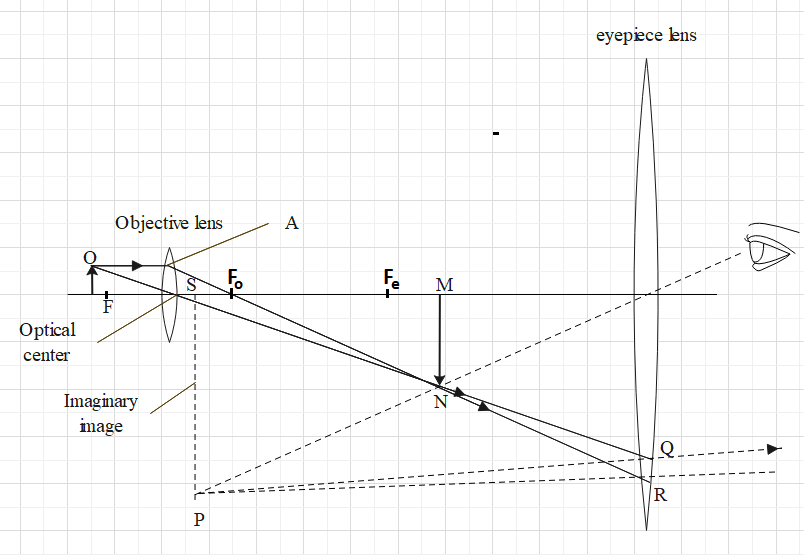
In a compound microscope, the intermediate image is:
A. Virtual, erect and magnified
B. Real, erect and magnified
C. Real, inverted and magnified
D. Virtual, erect and reduced
Answer
582.3k+ views
Hint: First, understand the working of the compound microscope. Find out what kind of lenses are used in the compound microscope. By knowing the types of lenses, find out the nature intermediate image formed in a compound microscope.
Complete step by step solution:

We have to find the nature of the intermediate image formed by the compound microscope.
In a microscope, the lens having a smaller focal length placed near the object is known as the objective lens and the lens having a larger focal length placed near the eye of an observer is known as the eyepiece.
From the above ray diagram, it is clear that an intermediate image is an image formed by an objective lens. An object is placed just beside the focus of an objective lens. We know that when an object is placed just beside the focus of the convex lens, a real, inverted, and magnified image is formed. Thus, as you can see in the ray diagram an intermediate image, MN, formed by the objective lens is a real inverted and magnified image. This intermediate image formed by an objective lens is used as an object for an eyepiece. And as you see, an eyepiece has a larger focal length and the intermediate image is formed near its focus, it further produces an enlarged image. As eyepiece is also a convex lens, it acts as a simple magnifier and does not re-invert the image, thus the final image produced is virtual and inverted.
Hence, the correct answer is option (C)
Note: A microscope is an instrument that is used for viewing enlarged or magnified images of very small objects. Any microscope is characterized by its magnifying power. Magnifying power measures how much an enlarged image can be formed using a given instrument. For example, if a microscope has magnification power \[1000X\]then the image would appear 1000 times larger than the actual size of the image. The total magnifying power of a microscope is equal to the combined magnifying power of each lens used. For example, if the objective has a magnifying power\[~10X\] and eyepiece has magnifying power \[100X\] then magnifying power of a microscope will be \[1000X\text{ }\left( 10\text{ }x\text{ }100 \right).\]
Complete step by step solution:

We have to find the nature of the intermediate image formed by the compound microscope.
In a microscope, the lens having a smaller focal length placed near the object is known as the objective lens and the lens having a larger focal length placed near the eye of an observer is known as the eyepiece.
From the above ray diagram, it is clear that an intermediate image is an image formed by an objective lens. An object is placed just beside the focus of an objective lens. We know that when an object is placed just beside the focus of the convex lens, a real, inverted, and magnified image is formed. Thus, as you can see in the ray diagram an intermediate image, MN, formed by the objective lens is a real inverted and magnified image. This intermediate image formed by an objective lens is used as an object for an eyepiece. And as you see, an eyepiece has a larger focal length and the intermediate image is formed near its focus, it further produces an enlarged image. As eyepiece is also a convex lens, it acts as a simple magnifier and does not re-invert the image, thus the final image produced is virtual and inverted.
Hence, the correct answer is option (C)
Note: A microscope is an instrument that is used for viewing enlarged or magnified images of very small objects. Any microscope is characterized by its magnifying power. Magnifying power measures how much an enlarged image can be formed using a given instrument. For example, if a microscope has magnification power \[1000X\]then the image would appear 1000 times larger than the actual size of the image. The total magnifying power of a microscope is equal to the combined magnifying power of each lens used. For example, if the objective has a magnifying power\[~10X\] and eyepiece has magnifying power \[100X\] then magnifying power of a microscope will be \[1000X\text{ }\left( 10\text{ }x\text{ }100 \right).\]
Recently Updated Pages
Master Class 12 Business Studies: Engaging Questions & Answers for Success

Master Class 12 Social Science: Engaging Questions & Answers for Success

Master Class 12 English: Engaging Questions & Answers for Success

Master Class 12 Chemistry: Engaging Questions & Answers for Success

Class 12 Question and Answer - Your Ultimate Solutions Guide

Master Class 12 Economics: Engaging Questions & Answers for Success

Trending doubts
What are the major means of transport Explain each class 12 social science CBSE

Which are the Top 10 Largest Countries of the World?

Draw a labelled sketch of the human eye class 12 physics CBSE

How much time does it take to bleed after eating p class 12 biology CBSE

Explain sex determination in humans with line diag class 12 biology CBSE

When was the first election held in India a 194748 class 12 sst CBSE




